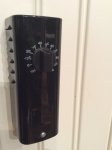AboveBeyond
Shohin
I bought a indoor garage heater for wintering my bonsai year due to the harsh winters over the last couple of years which saw consistent temps in the teens and below. My garage is a good insulator but can't maintain the temperature when it reaches below 20F (and definitely not when it reaches less than 10F).
What is the ideal temperate to set the garage heater to? I'm thinking 36-38F to keep it above freezing but cool enough not to get in the 40s. Most of my trees are maples but I also have tridents, azaleas (fares the worst), chojubai quince, korean hornbeams, Japanese boxwood along with conifers (JBP and junipers but i'm not worried about these guys).

http://www.amazon.com/gp/product/B0000AXEZV?psc=1&redirect=true&ref_=oh_aui_detailpage_o08_s00
What is the ideal temperate to set the garage heater to? I'm thinking 36-38F to keep it above freezing but cool enough not to get in the 40s. Most of my trees are maples but I also have tridents, azaleas (fares the worst), chojubai quince, korean hornbeams, Japanese boxwood along with conifers (JBP and junipers but i'm not worried about these guys).

http://www.amazon.com/gp/product/B0000AXEZV?psc=1&redirect=true&ref_=oh_aui_detailpage_o08_s00

